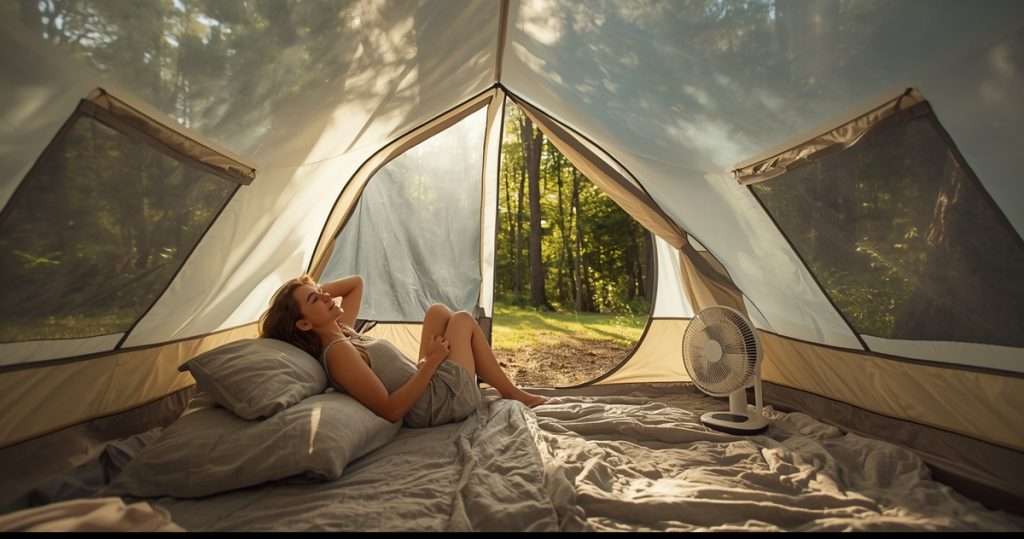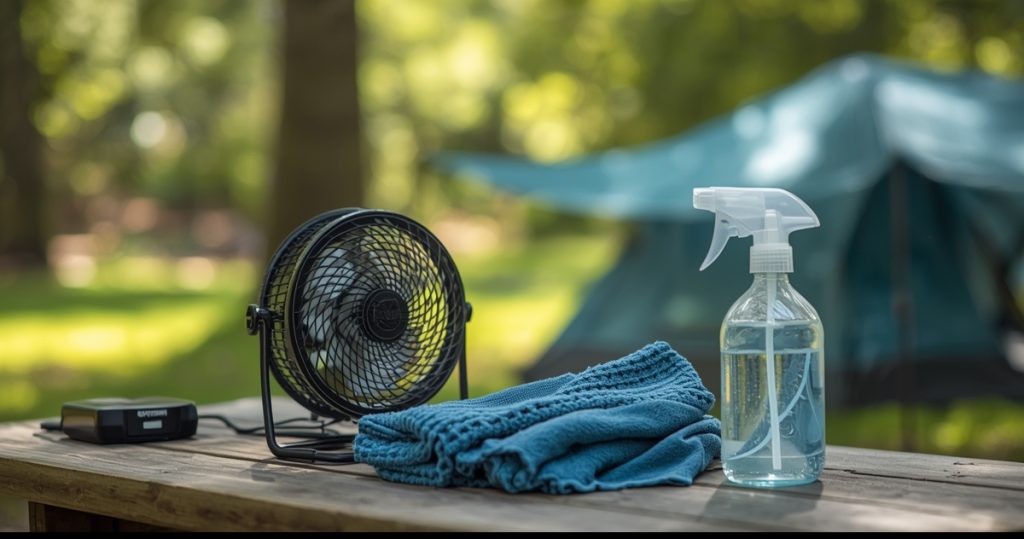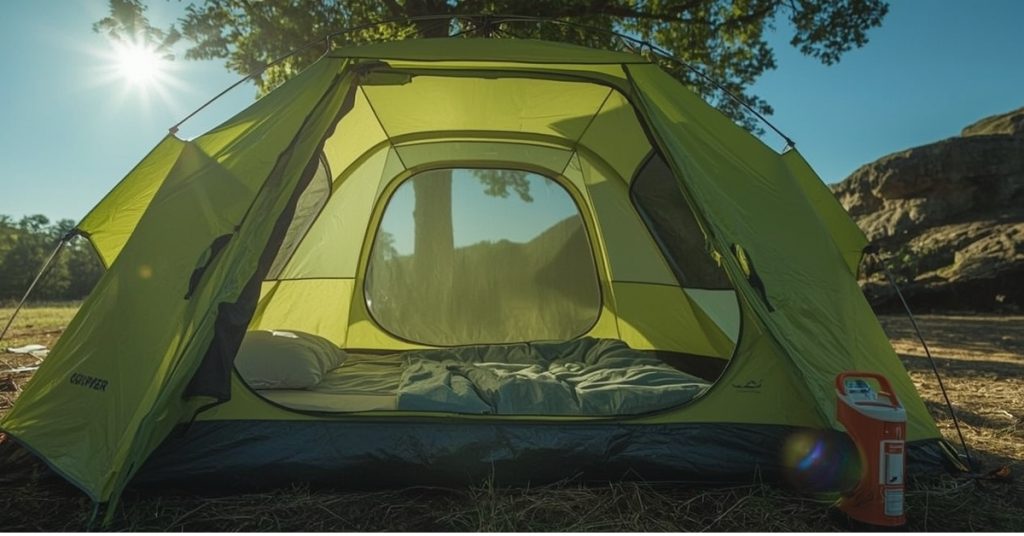As an Amazon Associate, I earn from qualifying purchases.
Camping in summer can be uncomfortable when tents trap heat, making sleep difficult and even risking heat-related issues. Fortunately, staying cool is possible without costly equipment. Simple strategies like choosing shaded tent sites, maximizing ventilation, and using breathable fabrics can significantly reduce indoor temperatures.
Additional tips include using reflective tarps, lightweight sleeping gear, and strategic airflow management to keep your tent comfortable. By combining these practical methods, campers can enjoy restful nights and stay safe during hot-weather adventures.
Contents
- 1 Why Staying Cool in a Tent Is Important
- 2 How to Stay Cool in a Tent (Step-by-Step)
- 2.1 Step 1: Set Up the Tent in a Shaded Area
- 2.2 Step 2: Use a Light-Colored or Reflective Rainfly or Tarp
- 2.3 Step 3: Open All Vents and Windows for Maximum Airflow
- 2.4 Step 4: Use a Portable Camping Fan or Battery-Powered Fan
- 2.5 Step 5: Sleep with Light Clothing and Breathable Bedding
- 2.6 Step 6: Place a Wet Towel Near Airflow for Evaporative Cooling
- 2.7 Step 7: Stay Hydrated and Avoid Heavy Meals Before Bed
- 3 Best Gear to Stay Cool in a Tent
- 4 Extra Tips for Hot Weather Tent Camping
- 5 How to Cool Down a Tent Without Electricity: Natural Solutions
- 6 Making the Most of Your Cool Tent Setup
- 7 Frequently Asked Questions
Why Staying Cool in a Tent Is Important

Maintaining comfortable temperatures inside your tent goes far beyond simple comfort—it’s crucial for your health, safety, and overall camping experience.
Prevents heat-related health issues
Excessive heat buildup can lead to dehydration, heat exhaustion, or even heat stroke. When your body can’t cool itself effectively in a confined space, these conditions develop rapidly and can become dangerous, especially for children, elderly campers, or those with medical conditions.
Improves sleep quality significantly
Your body naturally drops its core temperature when preparing for sleep. Hot, stuffy conditions interfere with this process, causing restless nights, frequent wake-ups, and daytime fatigue. Quality rest is essential for enjoying outdoor activities and staying alert while hiking or driving.
Reduces humidity and condensation problems
Overheated tents create excessive moisture from breathing and sweating. This leads to damp sleeping bags, wet tent walls, and that unpleasant clammy feeling that makes everything uncomfortable. Poor ventilation traps this moisture, creating ideal conditions for mold and mildew.
Controls insects and odors
Cooler, well-ventilated tents are less attractive to bugs that thrive in warm, humid environments. Better airflow also prevents the buildup of unpleasant odors from sweaty gear, food, or other camping essentials.
How to Stay Cool in a Tent (Step-by-Step)

Beat the heat with smart tent setup: choose shade, maximize airflow with vents and mesh, and use breathable fabrics. Add reflective tarps or lightweight gear, stay hydrated, and avoid indoor cooking. These steps keep your tent cool, comfortable, and safe in hot weather.
Step 1: Set Up the Tent in a Shaded Area
Location makes the biggest difference in tent temperature. Scout your campsite during the hottest part of the day to identify naturally cool spots.
Look for areas under large trees, near rock formations, or on the north side of hills where direct sunlight is blocked for most of the day. Morning shade is particularly important since temperatures start rising early.
Avoid low-lying areas where hot air settles, and stay away from reflective surfaces like rocks, sand, or pavement that radiate heat long after sunset.
Step 2: Use a Light-Colored or Reflective Rainfly or Tarp
Dark colors absorb heat while light colors reflect it. If your tent came with a dark rainfly, consider investing in a light-colored or reflective tarp to place above it.
Set up the tarp 12-18 inches above your rainfly to create an air gap. This double-roof system blocks direct sunlight while allowing hot air to escape between the layers. The air gap acts as insulation, preventing absorbed heat from reaching your tent.
Reflective emergency blankets or specialized camping tarps work exceptionally well for this purpose and pack down small for backpacking trips.
Step 3: Open All Vents and Windows for Maximum Airflow
Cross-ventilation is your most powerful cooling tool. Open every vent, window, and zipper panel your tent offers to create airflow pathways.
Position openings to catch prevailing breezes—typically, this means having one opening facing the wind direction and another on the opposite side for air to exit. Even light breezes become effective cooling systems when channeled properly through your tent.
If there’s no natural wind, create your own air movement by positioning openings at different heights. Hot air rises and escapes through higher vents while cooler air enters through lower openings.
Step 4: Use a Portable Camping Fan or Battery-Powered Fan
A quality portable fan transforms stagnant air into refreshing circulation. Battery-powered fans designed for camping can run for hours on rechargeable power banks or D-cell batteries.
Position the fan to pull hot air out of the tent rather than just circulating it. Place it near the top of your tent opening, pointing outward, to create a vacuum effect that draws cooler air in through other vents.
USB fans that connect to portable power banks offer excellent battery life and take up minimal space in your pack.
Step 5: Sleep with Light Clothing and Breathable Bedding
Heavy sleeping bags trap body heat and create uncomfortable sleeping conditions. Switch to lightweight, breathable alternatives that wick moisture away from your skin.
Cotton sheets, sleeping bag liners, or ultralight summer sleeping bags allow better air circulation around your body. Moisture-wicking sleepwear keeps you dry and comfortable throughout the night.
Consider bringing a pillow with a cooling gel insert or breathable mesh cover. Even small comfort improvements add up to significantly better sleep quality.
Step 6: Place a Wet Towel Near Airflow for Evaporative Cooling
This simple physics trick can drop your tent temperature by several degrees. Hang a damp towel or cloth near your tent’s air intake so incoming air passes over the wet surface.
As water evaporates from the towel, it absorbs heat from the surrounding air, creating a natural air conditioning effect. Refresh the towel with water as it dries out for continued cooling.
For maximum effectiveness, use this technique with a fan to increase air movement across the wet surface.
Step 7: Stay Hydrated and Avoid Heavy Meals Before Bed
Your body generates internal heat through digestion and dehydration makes it harder to regulate temperature effectively. Drink plenty of water throughout the day, but especially before bedtime.
Avoid large, protein-heavy meals close to sleep time since digestion produces significant body heat. Light snacks with high water content, like fruits or vegetables, are better evening options.
Keep water bottles within reach during the night for easy hydration without leaving your sleeping area.
Best Gear to Stay Cool in a Tent
Camping in hot weather can be challenging, but with the right gear, you can stay comfortable and enjoy your outdoor adventures. Here are some top-rated products designed to keep your tent cool and enhance your camping experience:
Portable Tent Fans
Look for fans specifically designed for camping with long battery life, quiet operation, and multiple speed settings. Models with LED lights serve double duty for nighttime convenience. USB-powered fans work well with solar panels or power banks for extended trips.
Reflective Sunshades and Tarps
Reflective tarps with grommets are versatile cooling tools that also provide extra shelter. Emergency blankets work in a pinch but lack durability. Silver-coated tarps offer the best combination of heat reflection and longevity.
Mesh Tents for Maximum Ventilation
Tents with large mesh panels provide superior airflow compared to solid-wall designs. Many modern tents offer removable rainflies that can be left off during clear, hot nights for maximum ventilation.
Cooling Towels and Misting Bottles
Specialty cooling towels stay cool for hours when dampened and provide instant relief when placed on pulse points. Spray bottles create refreshing mist that evaporates quickly for immediate cooling.
Lightweight Sleeping Systems
Summer sleeping bags rated for temperatures above 50°F prevent overheating. Sleeping pads with ventilated designs allow air circulation underneath your body. Cotton or bamboo sheets offer natural breathability superior to synthetic materials.
Extra Tips for Hot Weather Tent Camping

Maximize ventilation with a mesh tent and open vents, pitch in shade, and use battery-powered fans. Wear lightweight clothing, use a sleeping sheet, stay hydrated, and consider a cold shower or hammock to stay cool.
Time your setup strategically
Pitching your tent after sunset lets you avoid working in peak heat and allows the ground to cool down before you sleep. If you must set up during the day, do it early morning when temperatures are lowest.
Remove the rainfly for ventilation
Clear nights allow you to remove the rainfly completely for maximum airflow. Check weather forecasts carefully and be prepared to quickly replace it if conditions change.
Choose campsites near water sources
Rivers, lakes, and streams create cooler microclimates through evaporation. The temperature difference can be 10-15 degrees compared to inland areas. Position your tent to catch breezes coming off the water.
Create DIY air conditioning with frozen water bottles
Freeze water bottles before your trip and place them near air intake points. As they melt, they cool incoming air while providing cold drinking water. This technique works best with good ventilation to circulate the cooled air.
Seek higher elevations
Temperature drops approximately 3-4 degrees Fahrenheit for every 1,000 feet of elevation gain. Mountain camping naturally provides cooler conditions, though you’ll need appropriate gear for potentially cold nights.
Use ground insulation wisely
While sleeping pads provide comfort, they also trap heat. Consider using minimal ground insulation in very hot conditions, or choose pads with ventilation channels that allow air circulation.
How to Cool Down a Tent Without Electricity: Natural Solutions
When car camping isn’t an option and electrical cooling devices are unavailable, natural cooling methods become essential for comfortable tent camping.
Harness natural wind patterns
Study how air moves around your campsite throughout the day. Valley breezes often flow uphill during the day and downhill at night. Position your tent to catch these natural air currents for consistent cooling.
Create thermal chimneys
Use tent geometry to your advantage by creating pathways for hot air to escape. Set up one opening low on the side facing cooler ground and another opening high on the opposite side. This creates natural convection that pulls hot air out continuously.
Leverage ground cooling
The earth stays cooler than air temperature, especially a few inches below the surface. Dig a shallow depression under your tent area (where permitted) to take advantage of this natural cooling. Restore the area when you leave.
Master evaporative cooling techniques
Beyond wet towels, consider hanging damp clothing inside your tent where air passes over it. The evaporation process continuously removes heat from the air. This works best in dry climates where humidity levels are low.
Making the Most of Your Cool Tent Setup

Pitch your tent in the shade and orient the door toward prevailing winds to encourage natural airflow. Choose a light-colored, well-ventilated tent with mesh panels, and consider adding a reflective tarp above to block direct sunlight. Enhance cooling with battery-operated fans, and swap heavy sleeping bags for a lightweight liner or sheet. Sleeping off the ground on a cot or air mattress can further reduce heat.
Prep for bedtime by taking a cool shower or swim and staying hydrated to help regulate body temperature. During the day, air out your tent or consider a hammock for better ventilation. These simple steps keep your tent cooler, more comfortable, and ensure a restful night even in hot weather.
Final Verdict
Beating the heat while tent camping is all about preparation, smart setup, and the right gear. Choose shaded campsites, maximize airflow, and invest in breathable bedding. Portable fans and evaporative cooling can make even the hottest nights manageable. Test your strategies ahead of time so you’re ready when temperatures rise. With these tips, you’ll enjoy restful sleep, stay cool and comfortable, and wake ready for your next adventure.
Frequently Asked Questions
Can I use an air conditioner in a tent?
Portable air conditioners designed for camping exist but require significant power sources like generators or large battery systems. They’re practical for car camping with electrical hookups but impractical for backcountry camping. Most campers find natural cooling methods more practical and environmentally friendly.
What is the best type of tent for hot weather?
Tents with maximum mesh paneling, multiple vents, and light-colored fabrics perform best in hot weather. Four-season tents designed for winter conditions trap too much heat. Look for three-season tents with large vestibules and full rainfly removal options.
Does removing the rainfly help cool the tent?
Yes, removing the rainfly dramatically improves ventilation on clear nights. The rainfly blocks airflow even when vents are open. Only remove it when rain isn’t forecast and dew won’t be problematic for your gear.
Are blackout tents hotter or cooler?
Blackout tents are typically hotter because dark colors absorb more heat during the day. While they block light effectively for better sleep, they require more aggressive cooling strategies. Light-colored tents reflect heat better but may require eye masks for darkness.
Is it safe to sleep in a tent during extreme heat?
Extreme heat warnings require serious safety considerations. If temperatures exceed 90°F with high humidity, consider alternative shelter options. Always prioritize hydration, watch for heat exhaustion symptoms, and have evacuation plans for severe weather conditions.
As an Amazon Associate, I earn from qualifying purchases.
